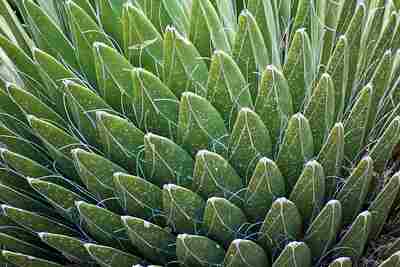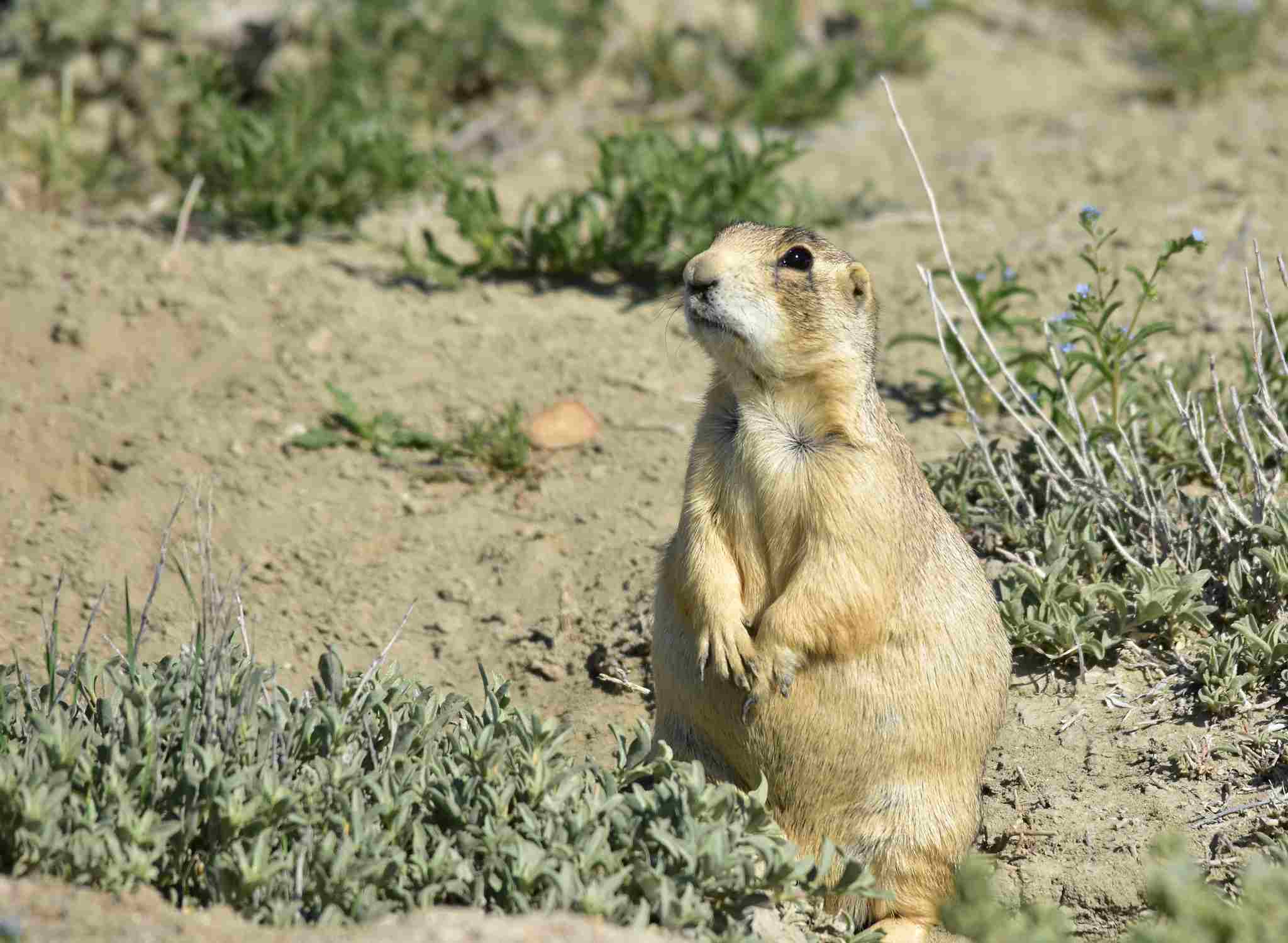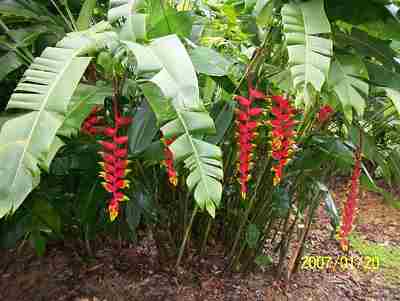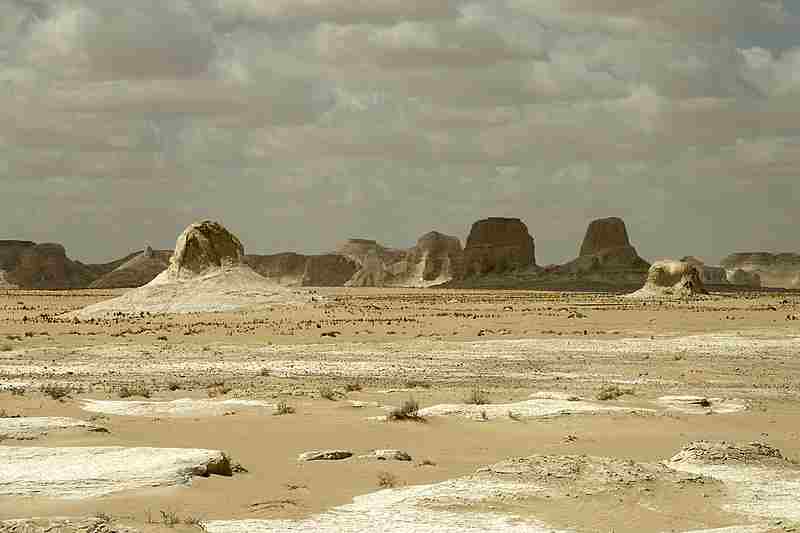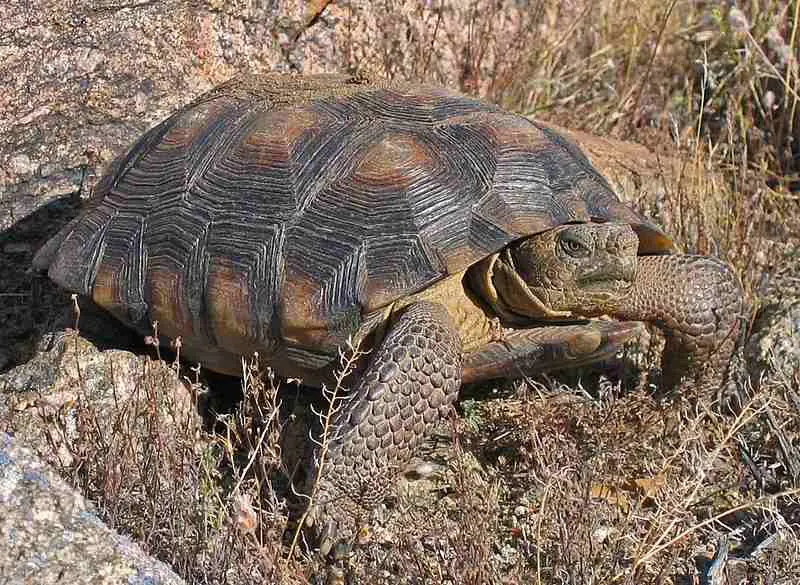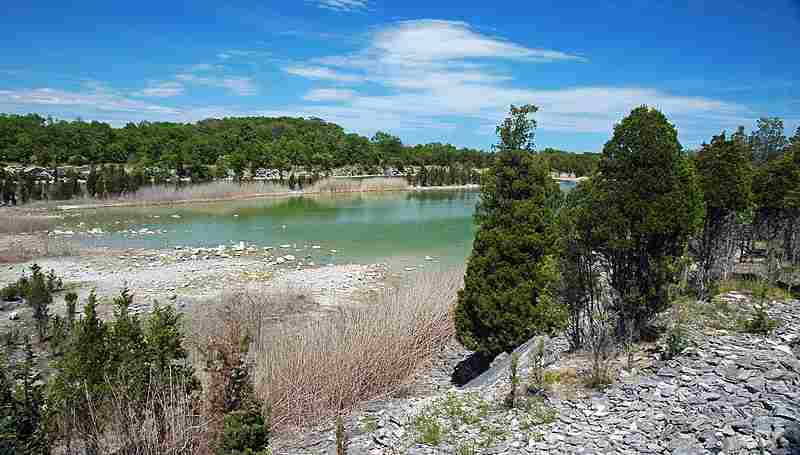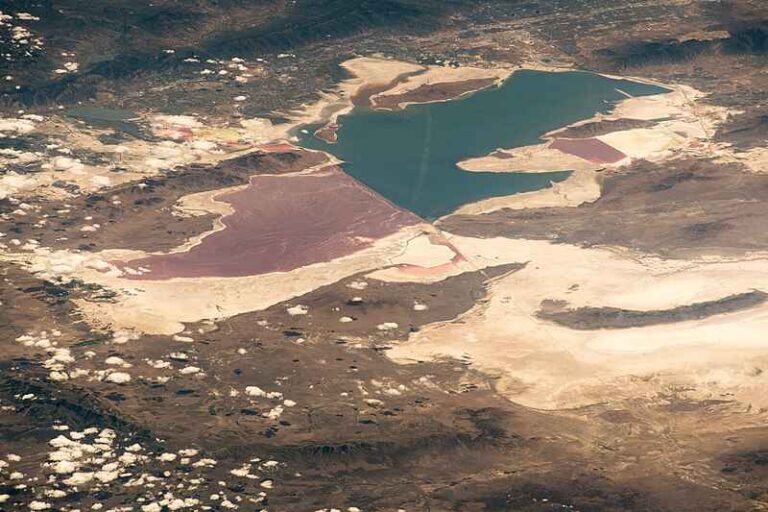11 Adaptations of Plants in the Desert Discussed
Adaptations of plants in the desert are; small leaves, waxy cuticles, sunken stomata, rolled-up leaves, nighttime blooming, succulent stems, spines and thorns, poisonous secretions, extensive root system, brightly colored flowers, and seedless reproduction.
This article discusses the adaptations of plants in the desert, as follows;
-Adaptations of Desert Plants for Water Conservation and Drought-Tolerance
1). Small Leaves (as one of the Adaptations of Plants in the Desert)
Many desert plants have evolved various adaptations for survival in harsh, arid environments.
One of these adaptations is the possession of small leaves. Desert plants, including succulents like cacti, and some shrubs, are characterized by small leaf size, along with modified leaf structures that enable them cope with extreme temperatures and limited water availability [8].
Examples of Desert Plants With Small Leaves
1). Cacti
Cacti are a group of well-known, succulent desert plants which have evolved to thrive under arid conditions.
They produce small, spiky and thick leaves called spines [2]. These spines aid in reducing water loss, by minimizing the surface area exposed to heat and dry desert air.
2). Desert Shrubs
Various kinds of shrubs that grow in desert environments, including the brittlebush (Encelia farinosa) and desert lavender (Hyptis emoryi) are characterized by narrow, small leaves.
In many cases, these leaves are covered with a waxy cuticle for water conservation through minimal transpiration.

Importance of Small Leaves as an Adaptation in Desert Plants
The importance of small leaves in desert plants includes water conservation, heat-tolerance, drought-tolerance, and protection from herbivores/herbivory. Each of these points is briefly discussed below;
1. Water Conservation
Small leaves reduce the total surface area from which water can evaporate.
In arid regions, the availability of water is limited, so that plants must conserve water in order to survive.
Having smaller leaves helps desert plants to minimize the loss of water through transpiration, and thereby improves efficiency of water-use.
2. Heat Tolerance
Desert environments are prone to high temperatures, especially during the day [11].
Small leaves provide less surface area to expose to solar radiation, and this helps in regulating leaf temperature, while preventing excessive evaporation and water loss.
3. Drought Tolerance
Small leaves are less susceptible to drying-out or desiccation, than larger leaves [9].
Reduced surface area, spines, scales and other modified leaf structures, may help trap a layer of still air close to the leaf surface, which serves as an insulator and reduces the rate of water loss.
4. Protection from Herbivores/Herbivory
Small leaves in desert plants often occur along with thorns or spines that physically protect the plants against herbivores, and deter these herbivores from feeding on plant tissues.
*Why Many Desert Plants Have Small Leaves
Many desert plants have small leaves as an adaptive feature to the harsh and unusual conditions of their habitats.
Small leaves help these plants regulate their temperature, reduce water loss, and minimize the impact of herbivory.
These effects allow desert plants survive with extreme temperatures, limited water resources and presence of herbivores.
*Summary on the Leaves of Desert Plants
The leaves of desert plants can vary in shape, structure and size, depending on the specific desert environment, and the species involved.
While some desert plants produce modified, small leaves like scales or spines, others may produce larger leaves with other adaptations to minimize the rate of water loss; such as a thick epidermal layer, or waxy cuticle.
Some desert plants may also shed their leaves during extremely dry periods in order to conserve water.
2). Waxy Cuticles
One of the adaptations which desert plants have evolved to survive in arid terrains, is the presence of a waxy cuticle on their stems and leaves [5].
A waxy cuticle is a waterproof, thin layer comprising of cutin and waxes, which are protective substances secreted by epidermal cells. Because it adds to the bulk of the epidermis in desert plants, it is often described as a thick, waxy cuticle.
Examples of Desert Plants with a Thick Waxy Cuticle
Some examples of desert plants with a thick waxy cuticle include: desert shrubs and succulents.
1). Thick Waxy Cuticle in Desert Shrubs
Various desert shrubs, such as the creosote bush (Larrea tridentata), produce leaves that have a thick waxy cuticle.
This adaptive feature facilitates the reduction of water loss through transpiration, thereby protecting the leaves from desiccation.
2). Thick Waxy Cuticle in Desert Succulents
Several succulent desert plants, such as agaves and cacti, possess thick, fleshy leaves which are covered with a layer of waxy cuticle.
This cuticle layer acts as a protective barrier that prevents excessive water loss, and enables the plants to retain significant amount of moisture in their tissues.

Importance of Waxy Cuticles in Desert Plants
The importance of waxy cuticles in desert plants includes; protection from dessication, heat tolerance, and water conservation.
1. Protection from Desiccation by Waxy Cuticles in Desert Plants
Desert plants are faced with the challenge of survival under extremely dry and harsh conditions, with limited availability of water.
The thick waxy cuticle layer, provides protection against excessive water loss that could cause drying-out or desiccation.
It reduces the permeability of leaf surfaces to water vapor, and helps to retain moisture within the tissues of these plants.
2. Heat Tolerance
The waxy cuticle in desert plants also plays a role in reducing solar thermal absorption on leaf surfaces, by reflecting sunlight [6].
This is useful for regulating leaf temperature, and prevents overheating, especially under the extreme daytime temperature-conditions of desert environments.
3. Water Conservation by Thick Waxy Cuticles in Desert Plants
Reducing water loss is the primary function of waxy cuticles in desert plants.
The waxy layer serves as a hydrological and thermal barrier, which prevents water from escaping rapidly through the leaf surface in the process of transpiration.
It effectively seals the stem and leaf surfaces, thereby minimizing evaporation rates, and maintaining water balance within the tissues of the plant.
*How Waxy Cuticle is an Adaptation to/for Photosynthesis in Desert Plants
The waxy cuticle in desert plants is an adaptation for efficient photosynthesis with minimal water loss.
By reducing the rate of water loss through transpiration, waxy cuticles help maintain adequate hydration within the tissues of the plant, and allow it to sustain optimal rates of photosynthesis (since water is an essential raw material for photosynthetic processes [12].
The cuticle serves as a protective barrier which mitigates excessive evaporation, and maintains the plant's internal water content, so that water remains available for photosynthetic processes.
*Why Desert Plants Have a Thick Waxy Cuticle
Desert plants have a thick waxy cuticle in order to cope with the challenges of living in arid regions.
The thick cuticle helps to prevent water loss through transpiration, which is vital for survival and water conservation in areas with limited water-availability.
The waxy layer reduces permeability of the leaf surface to the escape of water vapor, and creates a barrier that minimizes evaporation in order for the plant to retain moisture.
This adaptive feature enables desert plants to thrive in dry environments by the reduction of water stress; thereby increasing their chances of survival.
3). Sunken Stomata (as one of the Adaptations of Plants in the Desert)
Sunken stomata is a specialized structural adaptation in the leaves of many desert plants.
Stomata are a set of microscopic pores on the leaf surface, which allow for gas exchange, such as intake of carbon dioxide (CO2) for photosynthesis, and release of water vapor (H2O) and oxygen (O2) [4].
In desert plants, these stomata occur in depressions or small pits on the leaf surface, which gives them a sunken appearance, and reducing the rate of water vapor emission.
Examples of Desert Plants with Sunken Stomata
Examples of desert plants with sunken stomata include; agave and cacti. Each is briefly discussed below;
1). Sunken Stomata in Desert Agaves
Agave plants are known for their rosette growth-form and fleshy leaves, as well as for their possession of (deeply) sunken stomata [14].
These features have made the agave plants well-adapted to arid habitats, including the desert.
2). Sunken Stomata in Desert Cacti
Several species of cacti, including the prickly pear cactus (Opuntia spp.) and saguaro cactus (Carnegiea gigantea), have sunken stomata.
These plants have adapted to water scarcity and general arid conditions in desert environments.
Importance of Sunken Stomata in Desert Plants
The importance of sunken stomata in desert plants includes; minimal evaporation, protection from debris and dust, and enhanced efficiency of gas exchange.
1. Minimal Evaporation as a Result of Sunken Stomata in Desert Plants
The main function of sunken stomata in desert plants is reduction of water loss through transpiration.
Due to a lower, restricted position in the leaf surface, within the pits or depressions, the stomata are covered or sheltered from direct exposure to the dry air.
This physical configuration creates a microclimate around the stomata that is less harsh than the external surroundings, thereby conserving water in the plant.
The same mechanism also reduces evaporative water loss by decreasing air movement across the stomatal openings.
2. Protection from Debris and Dust
The sunken stomata are shielded partially by the raised epidermal cells that surround them.
This physical protection prevents the entry of debris and dust particles into the stomatal openings, which could be harmful and may clog them or interfere with their functioning.
3. Enhanced Efficiency of Gas Exchange
Sunken stomatal arrangement in desert plants, creates a microenvironment around the stomatal openings, where air movement is reduced and relatively-high humidity levels are maintained.
This can lead to more-efficient gas exchange, by optimizing the mechanism and rate of diffusion of CO2, into the leaf for photosynthesis; as well as minimizing water loss through transpiration.
4). Rolled-Up Leaves
Rolled-up leaves are an adaptation commonly found in desert plants.
This adaptation is characterized by the rolling or curling of leaves along their longitudinal axis, which results in a cylindrical or tubular shape.
Rolled-up leaves is a particularly prominent feature in xerophytic plants, that are adapted to arid terrains with limited availability of water.
There are several advantages which rolled-up leaves offer for desert plants, in terms of protection against harsh conditions, and water conservation.
Examples of Desert Plants with Rolled-Up Leaves
Examples of desert plants with rolled-up leaves include; desert grasses and succulents like agave.
Some desert grasses, like Stipa species, have rolled leaves [7].
The rolled leaf structure helps to minimize water loss by limiting the surface area of exposure, of leaves to wind and direct sunlight.
Agave plants often exhibit rolled-up leave structures as well. The rolled structure plays a role in reducing the surface area of the leaf that is exposed to the desert air, and minimizes water loss through transpiration.

Importance of Rolled-Up Leaves in Desert Plants
Importance of rolled-up leaves in desert plants includes; heat protection, protection against herbivory, and dessication prevention
1. Rolled-Up Leaves as an Adaptation of Plants in the Desert for Heat Protection
Rolled-up leaves establish a physical barrier which protects the tissues of leaves from excessive solar heat.
By curling their leaves inward, desert plants can minimize exposure to intense radiation from the Sun, and reduce the risk of damage (of vital tissues) by high temperatures.
2. Rolled-Up Leaves as an Adaptation of Plants in the Desert for Protection Against Herbivores
The rolled-up shape of leaves in the desert can serve as a physical deterrent to herbivores? especially when the leaves have thick epidermal layers.
Tough and curled leaves are less accessible, and more difficult to consume than flat, exposed leaves. This adaptation therefore provides some defense against herbivory, while helping to preserve vital photosynthetic tissues of plants.
3. Dessication Prevention
By rolling up its leaves, a desert plant reduces the exposed surface area of contact with dry air in its surroundings.
This creates a microclimate within the rolled-up leaf structure, where moisture is conserved and water loss is reduced.
The rolled-up leaf structure also helps to trap a stationary layer of air within the rolled space.
This trapped air-layer acts as an insulator, by reducing air flow and preventing rapid evaporation from the leaf surface. The ultimate result is a lower risk of dehydration and dessication.
5). Nighttime Blooming (as one of the Adaptations of Plants in the Desert)
Some desert plants have evolved so that they bloom exclusively during the night; a phenomenon known as nocturnal or night-shift blooming [1].
This unique adaptation allows the plants to optimize their reproduction, while minimizing impacts of the harsh desert environment.
Nighttime blooming strategy in desert plants can be attributed to several factors.
Examples of Desert Plants that Exhibit Nighttime Blooming
Examples of desert plants that exhibit nighttime blooming include; evening primrose and night-blooming cereus.
Evening Primrose (Oenothera spp.) includes various species like Oenothera primiveris and Oenothera caespitosa, which produce vibrant yellow flowers that open at dusk/evening and stay open throughout the night [16]. They attract nocturnal pollinators including insects like moths.

Night-blooming Cereus (Peniocereus greggii) is a cactus species native to the Sonoran Desert of North America. It is known for its fragrant and large, white flowers that exclusively open at night. These flowers attract nocturnal pollinators, such as moths and bats.
Nighttime blooming protects the sensitive flowers of desert plants from intense heat in the daytime
Importance of Nighttime Blooming as one of the Adaptations of Plants in the Desert
The importance of nighttime blooming in desert plants includes; water conservation, avoidance of unfavorable competition, protection against herbivory, and effective nocturnal pollination.
1. Water Conservation
Blooming in the nighttime is an adaptive strategy that enables desert plants to conserve water.
In arid terrains, daytime temperatures are often extremely hot, leading to increased water loss by evaporation and transpiration.
By blooming at night, plants minimize water loss from their flowers and other related components, as cooler temperatures (and slightly-higher humidity levels) at this time help to reduce the rate of evaporation.
This adaptation therefore allows desert plants optimize their efficiency of water-use, as well as their survival under water-limited conditions.
2. Avoidance of Unfavorable Competition
As an adaptation of plants in the desert, nighttime-blooming behavior can spare smaller plants some of the intense and potentially-harmful competition for resources that occurs during the day.
Many desert plants are faced with severe competition for limited resources like pollinators and water.
By blooming at night, some of these plants avoid such direct competition, with other plant species that bloom predominantly during the day.
This temporal niche-separation, helps night-blooming plants to exploit available resources in a less-rowdy and more effective manner, thereby reducing the competition for pollinators, and increasing the chances of successful pollination, as well reproduction.
3. Protection against Herbivory as a Result of Nighttime Blooming in Desert Plants
Nocturnal blooming can serve as a mechanism of defense against diurnal herbivores.
By blooming at night, desert plants are able to attract nocturnal pollinators, without also calling the attention of herbivores with their colorful flowers.
Several insect, reptilian and mammalian herbivores in the desert, are more active in the daytime during which they do most of their grazing.
Night-blooming plants can escape the direct attention of these herbivores, reducing the risk of extensive damage to both flowers and leaves.
4. Effective Nocturnal Pollination Due to Nighttime Blooming in Desert Plants
Most desert plants that bloom after sunset, rely on nocturnal pollinators for their reproduction.
In arid environments, nocturnal pollinators like moths and lesser long-nosed bats [15], are active under cooler nighttime temperatures, and are adapted specifically to low-light conditions.
By blooming at night, these plants increase their chances of attracting these nocturnal pollinators during hours when pollination can be most effective.
This unique relationship between nocturnal pollinators and night-blooming plants, ensures the successful transfer of pollen and production of seeds, both of which are very essential to sustain the fragile species richness, diversity and equilibrium of the desert ecosystem.

6). Succulent Stems
Many desert plants have evolved a unique adaptation referred to as succulent stems, which involves the development of fleshy, thick stems that can store significant amounts of water.
The succulent stem adaptation enables desert plants to thrive in arid regions where water availability is low and supply is intermittent.
Green and succulent stems are a vital characteristic of several desert plant species.
Examples of Desert Plants with Succulent Stems
Examples of desert plants with succulent stems include: aloe vera and cacti plants respectively.
Aloe Vera (Aloe barbadensis) is a succulent specie of plant that is known to thrive in desert regions.
Its stem comprises of thick, gelatinous tissues that are capable of storing water.
Aloe vera stems also possess chlorophyll pigments (as indicated by their green coloration), which allow the plant to produce chemical energy through photosynthesis, thereby functioning as a producer in the desert food web.

Cacti are another well-known group of desert plants with succulent stems, that are fully adapted to arid environments. They have developed various types of stems in their evolution, including columnar, flattened and cylindrical forms; all of which can be used for water storage.
Like aloe vera, their stems possess chlorophyll that enables them carry out photosynthesis and produce energy even under conditions of low light-intensity.
Importance of Succulent Stems in Desert Plants
The importance of succulent stems in desert plants includes; reduced transpiration, water storage, structural support, and photosynthesis.
1. Reduced Transpiration as a Result of Succulent Stems in Desert Plants
Succulent stems in desert plants, are instrumental toward reducing transpiratory water loss.
The thick epidermal, outer layer of the stems, along with the waxy cuticle, helps minimize evaporation of water, and prevent excessive loss. This allows the plants to conserve water, and maintain their level of hydration in spite of dry air and high temperatures in their surroundings.
2. Water Storage
Water storage is a primary function of succulent stems in desert plants.
As a result of adaptation to their arid habitat, these plants have developed specialized stem which can store water during periods of relatively-high humidity and/or rainfall.
Succulent stems act as reservoirs that enable the plants to survive prolonged drought periods, by drawing upon the stored water when external moisture-availability is low, thereby increasing their survival rate.
3. Structural Support by Succulent Stems in Desert Plants
Succulent stems also provide structural support to desert plants in which they occur.
The rigid and fleshy nature of the stems, helps the plants to maintain an upright form even with poor bottom-anchorage, in rocky or sandy desert soils.
The stems also help balance the weight of the plant, providing stability in windy conditions.
4. Photosynthesis
It is essential for desert plants to carry out photosynthesis, in order to produce energy.
The green coloration of succulent stems of these plants, is indicative of the presence of chlorophyll pigment, which is needed for photosynthesis.
This implies that desert plants with succulent stems can produce energy through photosynthesis, to supplement the photosynthetic activities of small (or absent) leaves. This capability helps them grow and sustain their metabolic activities.
-Adaptations of Desert Plants for Defense and Protection
7). Spines and Thorns (as one of the Adaptations of Plants in the Desert)
Many desert plants have evolved a defensive adaptation of thorns and spines on their leaves, stems, or branches.
These structures serve diverse important functions, and provide various advantages for survival in the harsh desert terrain.
Thorns and spines are specialized modified stipules, branches or leaves that have become pointed and rigid.
Examples of Desert Plants with Thorns and Spines
Examples of desert plants with spines and thorns include; acacias and cacti.
Some species of acacia, like Acacia tortilis, possess thorns along their branches, which serve as a defensive feature against herbivores.

Cacti are one of the most well-known desert plants that have spines.
They often possess these spines in various shapes, sizes and arrangements, which vary depending on the particular specie.
For example, the golden barrel cactus (Echinocactus grusonii) produces golden-yellow and densely-paced spines, while saguaro cactus (Carnegiea gigantea) possesses sharp, long spines.
Importance of Spines and Thorns in Desert Plants
The importance of spines and thorns in desert plants includes reduction of water loss, protection from herbivores, temperature regulation, and leaf modification.
1. Reduction of Water Loss
Spines and thorns in desert plants, play a role toward the reduction of water loss rates, from the plants' surface.
Thorns and spines differ from leaves, which have a larger surface area for transpiration, by having a relatively reduced surface area that minimizes both transpiration and evaporation.
This adaptation is vital for desert plants because it helps them conserve water.
2. Protection from Herbivores
Defense against herbivores is one of the main functions of thorns and spines in desert plants.
The pointed, sharp structures are physical deterrents that prevent animals from browsing or grazing on the tissues of the host plant. They serve as an effective defense feature by inflicting injury or pain on potential herbivores, and dissuading them from consuming the plant.
3. Temperature Regulation
Spines and thorns can contribute to the regulation of temperature in desert plants.
By reducing the surface area which is directly exposed to sunlight, these structures minimize heat absorption and prevent overheating. This adaptation is particularly helpful in desert environments where extreme temperatures are common.
4. Leaf Modification
Spines and thorns are themselves modified structures that are derived from (and often represent) leaves.
In some desert plants, the complete loss or reduction of leaves has occurred while adapting to arid conditions, so that spines or thorns have taken over the aesthetic and photosynthetic functions of these leaves.
Most spines and thorns of desert plants have adapted to carry out photosynthesis, enabling the plant to still produce energy while traditional leaves are reduced or absent.
Role of Spines in Cacti Desert Plants
In cacti plants, spines are especially crucial for their survival in the arid environment.
The functions of spines in cacti include;
1. Water conservation
2. Defense against herbivores
8). Poisonous Secretions
One of the adaptation of plants in the desert is the ability to produce poisonous secretions.
These secretions may occur in the form of resins, milky latex, or toxic chemicals.
The presence of these toxic compounds in desert plants, serves diverse purposes, and aids their survival in the harsh desert habitat.
Examples of Desert Plants with Poisonous Secretions
Examples of desert plants with poisonous secretions include; desert milkweed and euphorbia plants.
Desert milkweeds, like the balloon cotton-bush (Gomphocarpus physocarpus), and the apple of Sodom (Calotropis procera), produce toxic latex or sap that contain cardiac glycosides [10]. These compounds have significant toxicity levels and can be harmful to many animals, so that it deters herbivores and reduces the threat of herbivory.

Plants in the Euphorbia genus, like the crown of thorns (Euphorbia milii), and the pencil cactus (Euphorbia tirucalli) are known to produce a toxic milky latex [3]. Due to its toxicity, this latex serves as a deterrent against herbivores.
Importance of Poisonous Secretions in Desert Plants
The importance of poisonous secretions in desert plants includes; pathogen immunity and resistance, herbivore deterrence, seed dispersal and competitive advantage.
1. Pathogen Immunity as a Benefit of Poisonous Secretions in Desert Plants
Poisonous secretions in desert plants often also have antimicrobial characteristics, so that they provide protection against pathogens like fungi and bacteria.
The toxic compounds help prevent diseases and infections that could harm the plant.
By producing these substances, desert plants increase their chances of survival, especially in environments where the presence of pathogens may be significant.
2. Herbivore Deterrence
Herbivore deterrence is one of the main functions of poisonous secretions in desert plants.
The toxic compounds function as chemical deterrents that discourage primary consumers from feeding on the plant.
Desert plant toxins may cause vomiting, nausea, or death in herbivores, thereby effectively protecting the plant from being consumed.
This mechanism of defense is especially important in desert regions where resources are very limited, and plant survival relies heavily on the avoidance of excessive herbivory.
3. Seed Dispersal
For some desert plants, poisonous secretions are produced in their fruits or seeds.
These toxins are often for the purpose of deterring seed predators, and increasing the chances of successful dispersal of seed.
By discouraging desert animals from consuming the seeds or fruits, these plants ensure that they have a higher chance of dispersing their reproductive structures to new locations, including more favorable habitats.
4. Competitive Advantage
Desert plants are faced with intense competition for limited resources like water, space and nutrients.
The presence of poisonous secretions can give a competitive edge to certain desert plant species, by deterring other plants from growing in close proximity. Toxic compounds in these secretions may inhibit neighboring plant growth, thereby reducing competition for space and other essential resources. .
-Adaptations of Desert Plants for Access to Water and Nutrients
9). Extensive Root System (as one of the Adaptations of Plants in the Desert)
One of the adaptations which have evolved in desert plants for their survival in arid environments, is the ability to develop of an extensive root system.
This is a stark contrast to the adaptation of plants in the tundra and in (other) temperate zones, which features shallow roots designed to access water and nutrients in a shallow soil layer above the permafrost.
Roots of desert plants are adapted specially to maximize the absorption of water, and withstand the challenges of surviving in nutrient-deficient, dry soils.
Adaptations of Desert Plant Roots
Adaptations of desert plant roots include, lateral-spreading, deep taproot formation, and prominent root hairs.
1. Lateral Spreading in Desert Plant Roots
Desert plants may also produce lateral roots grow in a wide, spreading pattern, and are close to the soil surface.
Such root structures are useful for capturing water after rare events of rainfall, because their position enables them absorb moisture from shallow soil layers, where rainwater can be found in the early stages of percolation (before it is entirely absorbed in the dry lower layers of soil).
Examples of plants in the desert that produce lateral-spreading roots are shrubs like brittlebush (Encelia farinosa), and creosote bush (Larrea tridentata).
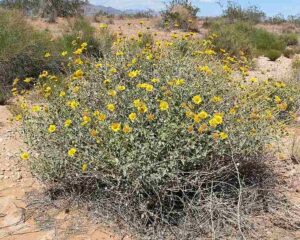
2. Deep Taproot Formation
Several desert plants, including desert ironwood (Olneya tesota) and mesquite trees (Prosopis spp.), may develop extensive and deep taproots.
These taproots grow deep into the soil, where they are able to access water sources in lower soil levels.
Deep taproots are beneficial for allowing desert plants to access water reserves that occur beyond the reach of shallower roots.
3. Prominent Root Hairs as an Adaptation of Plants in the Desert
Roots of desert plant, are often equipped with abundant hair-like and fine structures that could be referred to as root hairs [8].
These root hairs help increase the surface area of the entire root system, thereby improving the ability of the plant to absorb nutrients and water from soil.
Root hairs play a major role in enhancing the efficiency of water absorption for desert plants, as they make it possible to utilize even small amounts of water.
Importance of Extensive Root Systems in Desert Plants
The importance of extensive root systems in desert plants includes; soil stabilization, anchorage, acquisition of nutrients, and water absorption.
1. Soil Stabilization by Extensive Roots in Desert Plants
Desert plants that develop extensive root systems, are often involved in soil stabilization.
The dense root network of these plants, binds the particles of soil together, and reduces soil erosion by water and wind. This role is specially important in desert ecosystems where soils are fragile and susceptible to erosion.
2. Anchorage of Desert Plants by Their Extensive Root Systems
The deep taproots of some desert plants, provide them with anchorage and stability, especially in areas characterized by occasional dust storms and strong winds.
The deep roots secure these plants firmly in the ground, and prevent them from being destabilized or uprooted by mechanical stressors.
3. Acquisition of Nutrients
Extensive root systems enable desert plants to acquire essential nutrients from the soil.
Desert soils often contain limited nutrients; a characteristic that affects the growth of plants in arid zones.
The extensive root system of desert plants allows them to scavenge for nutrients across a larger area, so that their chances of finding these nutrients necessary are higher.
4. Water Absorption
The main function of an extensive root system in desert plants is to maximize their water absorption capability.
Both lateral spreading roots and deep taproots allow plants to explore a larger area and depth of soil, to improve access to available water resources.
This adaptation plays a role in the survival of desert plants during extended drought periods, by enabling them access water even in its scarcity.
-Adaptations of Desert Plants for Regeneration and Continuity
Adaptations of plants in the desert for regeneration and continuity are; brightly-colored flowers and seedless reproduction.
10). Brightly Colored Flowers
Brightly colored flowers in desert plants are an adaptation that is crucial toward their reproduction, generational continuity and survival.
Although the desert is associated with water scarcity and generally harsh conditions, several desert plants have evolved so that they are still able to produce vibrant flowers.
These colorful floral blooms serve multiple important functions, contributing to the overall success of their host plants.
Examples of Desert Plants with Brightly Colored Flowers
Examples of desert plants with brightly colored flowers are; saguaro cactus, desert mallow, and desert marigold.
Saguaro Cactus (Carnegiea gigantea) is an iconic succulent found in the Sonoran Desert [13].
Its physiological features include large white flowers which bloom nocturnally in spring and summer months, and attract pollinators like moths and bats.
Desert Mallow (Sphaeralcea ambigua) can be described as a shrub that grows in arid parts of North America. It produces vibrant red to orange flowers that attract pollinators like bees.

Desert Marigold (Baileya multiradiata) is a perennial plant which is native to arid parts of the North American region. It produces golden-yellow flowers that stand out against the sandy desert landscape.
Importance of Brightly Colored Flowers in Desert Plants
Importance of brightly colored flowers in desert plants includes; increased visibility, pollinator attraction, and genetic diversity.
1. Increased Visibility
In vast arid landscapes, the presence of brightly colored flowers increases the visibility of plants to pollinators even across long distances.
The vibrant colors enable flowers stand out against the monotonous backdrop of the desert, and is an especially important quality in desert ecosystems where plant density is low, and both pollinator populations and activities are also significantly low.
2. Pollinator Attraction
The conspicuous and bright colors of desert flowers are visual beacons that attract pollinators.
Effective/efficient pollination is very crucial for successful reproduction of many plants, in desert ecosystems where resources can be limited.
By producing vibrant flowers, these desert plants gain higher chances of attracting pollinators like moths, butterflies, birds and bees. Such pollinators help transfer pollen from flower to flower, and facilitate fertilization as well as production of seeds.
3. Genetic Diversity
Seed production and successful pollination are both vital for genetic diversification, and survival of plant populations in the desert.
Brightly colored flowers increase the chances and actual rate, of successful pollination, which leads to seed development. The seeds which are developed serve as a tools for dispersal, and enable plants to maintain genetic diversity within their populations, while colonizing new areas.
11). Seedless Reproduction (as one of the Adaptations of Plants in the Desert)
Seedless reproduction, also referred to as vegetative reproduction; is an adaptive strategy utilized by many desert plants to survive and propagate in their harsh environment.
In contrast to seed reproduction, that requires the production and dispersal of seeds, seedless reproduction enables plants to reproduce without depending on seeds. Rather, new plants grow from vegetative structures such as leaves, roots or stems, allowing for efficient and rapid reproduction.
Examples of Desert Plants that Employ Seedless Reproduction
Examples of desert plants that employ/utilize seedless reproduction are;
1. Aloe vera
2. Agave
3. Mesquite
The non-seed propagative parts of these plants include; plantlets, pups, offsets, and root suckers.
Importance of Seedless Reproduction in Desert Plants
Seedless reproduction in desert plants is important because it helps with;
1. Adaptation to harsh arid conditions
2. Rapid colonization of space
3. Resource conservation
4. Genetic uniformity
Conclusion
Adaptations of plants in the desert are;
1. Small Leaves
2. Waxy Cuticles
3. Sunken Stomata
4. Rolled-Up Leaves
5. Nighttime Blooming
6. Succulent Stems
7. Spines and Thorns
8. Poisonous Secretions
9. Extensive Root System
10. Brightly Colored Flowers
11. Seedless Reproduction
References
1). Aguilar-Rodriguez, P. A.; Krömer, T.; González, M. C. M. (2014). "The Secrets of Night-Blooming Bromeliads and Bats." Available at: https://www.academia.edu/69211440/The_Secrets_of_Night_Blooming_Bromeliads_and_Bats. (Accessed 8 July 2023).
2). Aliscioni, N. L.; Delbon, N.; Gurvich, D. E. (2021). "Spine function in Cactaceae, a review." Journal of the Professional Association for Cactus Development 23:1-11. Available at: https://doi.org/10.56890/jpacd.v23i.325. (Accessed 8 July 2023).
3). Basak, S.; Bakshi, P. K.; Basu, S.; Basak, S. (2009). "Keratouveitis caused by Euphorbia plant sap." Indian Journal of Ophthalmology 57(4):311-3. Available at: https://doi.org/10.4103/0301-4738.53060. (Accessed 8 July 2023).
4). Detlef, S. E. (2003). "Carbon Dioxide and Water Vapor Exchange in Response to Drought in the Atmosphere and in the Soil." Annual Review of Plant Biology 37(1):247-274. Available at: https://doi.org/10.1146/annurev.pp.37.060186.001335. (Accessed 8 July 2023).
5). Elhalim, A. E. M.; Abo-Alatta, O. Kh.; Habib, S. A.; Elbar, O. A. (2016). "The anatomical features of the desert halophytes Zygophyllum album L.F. and Nitraria retusa (Forssk.) Asch." Annals of Agricultural Sciences 61(1). Available at: https://doi.org/10.1016/j.aoas.2015.12.001. (Accessed 8 July 2023).
6). Franchini, M. C.; Hernández, L. F.; Lindström, L. I. (2010). "Cuticle and cuticular wax development in the sunflower (Helianthus annuus L.) pericarp grown at the field under a moderate water deficit." Phyton 79:153-161. (Accessed 8 July 2023).
7). Freitag, H. (1985). "The genus Stipa (Gramineae) in southwest and south Asia." Available at: https://www.researchgate.net/publication/285841097_The_genus_Stipa_Gramineae_in_southwest_and_south_Asia. (Accessed 8 July 2023).
8). Kirschner, G. K.; Xiao, T. T.; Blilou, I. (2021). "Rooting in the Desert: A Developmental Overview on Desert Plants." Genes (Basel). 2021 May 10;12(5):709. Available at: https://doi.org/10.3390/genes12050709. (Accessed 8 July 2023).
9). Leigh, A.; Sevanto, S.; Close, J. D.; Nicotra, A. B. (2017). "The influence of leaf size and shape on leaf thermal dynamics: does theory hold up under natural conditions?" Plant Cell Environ. 2017 Feb;40(2):237-248. Available at: https://doi.org/10.1111/pce.12857. (Accessed 8 July 2023).
10). Radford, D. J.; Gillies, A. D.; Hinds, J. A.; Duffy, P. (1986). "Naturally occurring cardiac glycosides." Med J Aust. 1986 May 12;144(10):540-4. Available at: https://doi.org/10.5694/j.1326-5377.1986.tb112283.x. (Accessed 8 July 2023).
11). Rewald, B.; Amir, E.; Shelef, O.; Hill, A.; Degu, A.; Friedjung, A.; Rachmilevitch, S. (2012). "Hot desert environments." Life at extremes - Environments, organisms and strategies for survival (pp.196-218). Available at: https://doi.org/10.1079/9781845938147.0196. (Accessed 8 July 2023).
12). Rizhsky, L.; Liang, H.; Mittler, R. (2003). "The water-water cycle is essential for chloroplast protection in the absence of stress." J Biol Chem. 2003 Oct 3;278(40):38921-5. Available at: https://doi.org/10.1074/jbc.M304987200. (Accessed 8 July 2023).
13). Rodriguez-Buritica, S.; Birt, T.; Raichle, H.; Webb, R. H.; Turner, R. M.; Pierson, E.; Venable, D. L. (2013). "Population dynamics of Sonoran Desert saguaro cactus ( Carnegiea gigantea ) at the Desert Laboratory (Tucson, Arizona)." Ecology 94(7):1660. Available at: https://doi.org/10.1890/13-0182.1. (Accessed 8 July 2023).
14). Sánchez-Arreola, E.; Maiti, R.; Ebeling, P. W.; Garcia-Guzman, J.; Jimenez-Neria, M. L., Maldonado-Zarian, R.; Ramirez, E. O. (2003). "A preliminary study on morpho-anatomical characters and secondary metabolites of agave "mezcalero" (Agave potatorum)." Available at: https://www.researchgate.net/publication/299161647_A_preliminary_study_on_morpho-anatomical_characters_and_secondary_metabolites_of_agave_mezcalero_Agave_potatorum. (Accessed 8 July 2023).
15). Slauson, L. A. (2000). "Pollination biology of two chiropterophilous agaves in Arizona." Am J Bot. 2000 Jun;87(6):825-36. Available at: https://www.jstor.org/stable/2656890. (Accessed 8 July 2023).
16). Timoszuk, M.; Bielawska, K.; Skrzydlewska, E. (2018). "Evening Primrose (Oenothera biennis) Biological Activity Dependent on Chemical Composition." Antioxidants 7(8):108. Available at: https://doi.org/10.3390/antiox7080108. (Accessed 8 July 2023).
